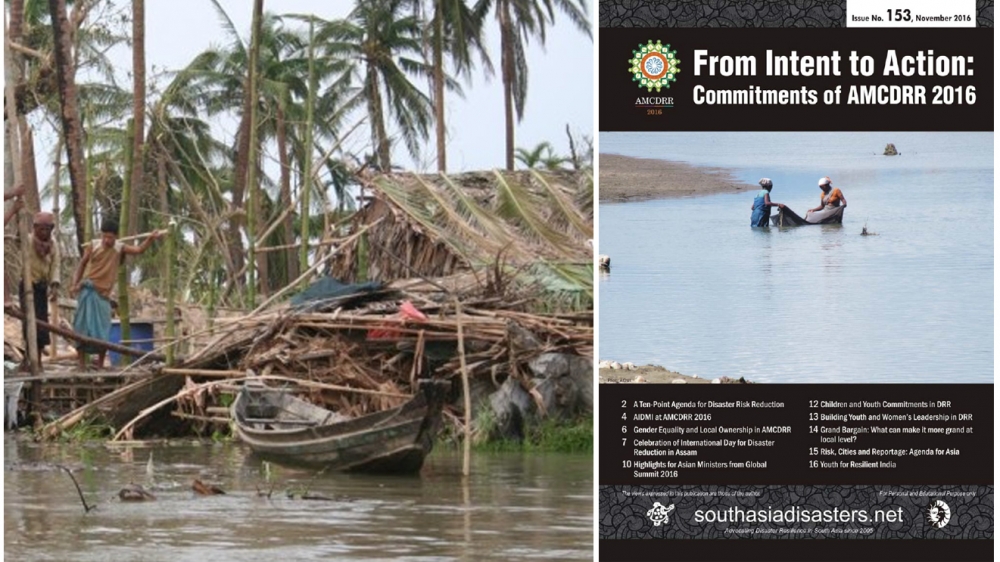From Intent to Action: Highlights for Asian Ministers
 Click here to read more
Click here to read more
The world is facing unprecedented crises and growing challenges. With an estimated 98.5 million people affected by disasters in 2015 alone, the number and scale of disasters triggered by natural hazards are increasing. There are 65 million people forcibly displaced both within and across borders, resulting in mounting humanitarian needs which are exceeding available resources. Meanwhile, the rate of globalisation and urbanisation makes the realities of health crises much harder to contain. The latest trends and lessons learned in disaster relief and resilience will be discussed at the Aid & Development Asia Summit, organised by the Aid & International Development Forum (AIDF) in Myanmar in June 2017.
Despite broad recognition that investing in resilience before a disaster can save lives and money, less than 13% of development assistance funding goes into disaster risk reduction. Lack of global investment in strengthening community resilience leaves tens of millions exposed to predictable and preventable disaster risks. The traditional approach to disasters is no longer viable in current escalating global crises. Investment in technology, solutions and partnerships that build resilience, improve livelihoods and support communities to resist future disasters and crises must be developed.
In order to achieve resilience, aid and development stakeholders must understand inequalities and specific drivers of risk for different communities. A people-centred approach to humanitarian action is required to strengthen the resilience of vulnerable and at-risk communities.
Connectivity
Access to information is critical to successful disaster risk management. When disaster strikes, real–time updates about evolving crisis situations and information about those affected, including their needs and locations, are paramount to effective emergency response and better decision–making. Gathering essential data to provide rapid disaster relief involves many challenges ranging from security of aid workers to cultural barriers and difficulties in communication.
Infrastructure
While connectivity and ICT increase the immediate impact of aid workers, improving efficiency of humanitarian response programmes and supporting disaster resilience, any communication solution is only as reliable as the infrastructure that supports it. Calamities often result in communities being cut off from rescue operators and with no means to access physical aid. While mass broadcasting channels continue to be part of the emergency response, remote areas face greater risk of being unreachable due to their underdeveloped infrastructure or infrastructure that has been compromised by the disaster. Furthermore, aid agencies need to ensure the wellbeing and safety of their teams in the field.
Partnerships
Strong Public Private Partnerships drive disaster risk reduction and resilience at the local and national level. Therefore it is important for international aid agencies and donors to partner with local organisations that have long-standing ties in affected regions, as they are best placed to determine and address immediate needs after disasters. Such partnerships also ensure that communities have systems in place for future disasters, beyond short– term relief.
For example, WeRobotics partnered with Kathmandu University to assess earthquake damage in Nepal with the use of drones. The flying robots captured the damage and carried out aerial surveys to support local recovery efforts. WeRobotics trained locals to use the technology and conduct additional 3-D modelling to create high-resolution maps of the most damaged areas. By involving local partners in developing countries and allowing them to gain professional skills, impact of humanitarian efforts is maximised and the access to robotics is democratised.
Data
It is important to look holistically at disasters and crisis response in order to ensure that the resources are being used in the best way possible. Data plays a vital role as it informs decisions, optimising effectiveness of humanitarian programmes and mitigating potential risk of future disasters. With help of data mining software, computer algorithms and statistical analysis, Big Data became useful in providing patterns and insights into complex situations, drawing on massive amounts of data generated with mobile phones, satellites and social media to avoid incomplete or inaccurate information. Along with crowd sourced data initiatives, Big Data analytics offer a holistic approach to decision-making, prediction and coordination of disaster response and humanitarian programmes.
Early warning systems
Disaster preparedness and early warning systems are also key part of reducing the effects of disasters. Together with the Nicaraguan government, General Electric is working on installing 80 wireless sensors inside Masaya, one of the country's active volcanoes, in order to gather real-time data to better predict its eruption. The data collected, including temperature and pressure, will be transmitted through the internet to an open-source database called Predix, which is also accessible by public. The American Institute of Physics (AIP) built a ring laser interferometer to detect storms, earthquakes, hurricanes and tornadoes, demonstrating the technology's potential as an earlywarning system for natural disasters.
Conclusion
Open source innovation can change how humanitarian and development stakeholders are able to resolve, not just respond to, global needs. Yet an integrated approach and collaboration between frontline aid agencies, donors and governments and the private sector is needed to address the most prominent challenges in building resilience and implementing programmes for disaster risk reduction.
Published in the recent issue of Southasiadisasters.net on ‘From Intent to Action: Commitments of AMCDRR 2016’. You can also download this issue from our website http://www.aidmi.org/publications.aspx
Click here to read more







